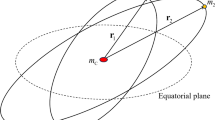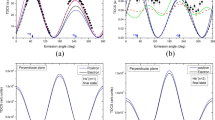Abstract
The classical hydrogen atom is examined for the situation where a circularly polarized electromagnetic plane wave acts on a classical charged point particle in a near-circular orbit about an infinitely massive nucleus, with the plane wave normally incident to the plane of the orbit. The effect of the phase α of the polarized wave in relation to the velocity vector of the classical electron is examined in detail by carrying out a perturbation analysis and then comparing results using simulation methods. By expanding the variational parts of the radius and angular velocity about their average values, simpler nonlinear differential equations of motion are obtained that still retain the key features of the oscillating amplitude, namely, the gradual increase of the envelope of the oscillating amplitude and the point of rapid orbital decay. Also, as shown here, these key features carry over nicely to conventional quantities of interest such as energy and angular momentum. The phase α is shown here to have both subtle yet very significant effects on the quasistability of the orbital motion. A far wider range of phase conditions are found to provide stability than might intuitively be expected, with the time to orbital decay, t d , varying by orders of magnitude for any plane wave with an amplitude A above a critical value, A c .
Similar content being viewed by others
REFERENCES
Cole, D. C., and Zou, Y. (2004). Simulation study of aspects of the classical hydrogen atom interacting with electromagnetic radiation: Circular orbits. J. Sci. Comput. Accepted for publication (expected publication date is Feb. 2004). Preprint available at http:// www.bu.edu/simulation/publications/dcole/publications.html.
Cole, D. C., and Zou, Y. (2004). Simulation study of aspects of the classical hydrogen atom interacting with electromagnetic radiation: Elliptical orbits. J. Sci. Comput. Accepted for publication (expected publication date is mid-2004). Preprint available at http://www.bu.edu/simulation/publications/dcole/publications.html.
Grochmalicki, J., Lewenstein, M., and Rzazewski, K. (1991). Stabilization of atoms in superintense laser fields: Is it real? Phys. Rev. Lett. 66(8), 1038–1041.
Griffiths, J. A., and Farrelly, D. (1992). Ionization of rydberg atoms by circularly and elliptically polarized microwave fields. Phys. Rev. A 45(5), R2678–R2681.
Braun, P. A. (1993). Discrete semiclassical methods in the theory of rydberg atoms in external fields. Rev. Mod. Phys. 65(1), 115–161.
Clark, W., and Greene, C. H. (1999). Adventures of a rydberg electron in an anisotropic world. Rev. Mod. Phys. 71(3), 821–833.
Yoshida, S., Reinhold, C. O., Kristofel, P., and Burgdorfer, J. (2000). Exponential and nonexponential localization of the one-dimensional periodically kicked rydberg atom. Phys. Rev. A 62, 023408.
Wesdorp, C., Robicheaux, F., and Noordam, L. D. (2001). Displacing rydberg electrons: The mono-cycle nature of half-cycle pulses. Phys. Rev. Lett. 87(8), 083001.
Muthukrishnan, A., and Stroud, C. R., Jr. (2002). Entanglement of internal and external angular momenta of a single atom. J. Opt. B.-Quantum S. O. 4, S73.
Tannor, D. J., and Rice, S. A. (1985). Control of selectivity of chemical reaction via control of wave packet evolution. J. Chem. Phys. 83, 5013.
Brumer, P., and Shapiro, M. (1986). Control of unimolecular reactions using coherent light. Chem. Phys. Lett. 126, 541.
Boyer, T. H. (1989). Scaling symmetry and thermodynamic equilibrium for classical electromagnetic radiation. Found. Phys. 19, 1371–1383.
Cole, D. C. (1990). Classical electrodynamic systems interacting with classical electromagnetic random radiation. Found. Phys. 20, 225–240.
Boyer, T. H. (1989). Conformal symmetry of classical electromagnetic zero-point radiation. Found. Phys. 19(4), 349–365.
Marshall, T. W. (1963). Random electrodynamics. Proc. R. Soc. London, Ser. A 276, 475–491.
Marshall, T. W. (1965). Statistical electrodynamics. Proc. Camb. Phil. Soc. 61, 537–546.
Boyer, T. H. (1969). Derivation of the blackbody radiation spectrum without quantum assumptions. Phys. Rev. 182, 1374–1383.
Boyer, T. H. (1969). Classical statistical thermodynamics and electromagnetic zero-point radiation. Phys. Rev. 186, 1304–1318.
Boyer, T. H. (1975). Random electrodynamics: The theory of classical electrodynamics with classical electromagnetic zero-point radiation. Phys. Rev. D 11(4), 790–808.
Puthoff, H. E. (1987). Ground state of hydrogen as a zero-point-fluctuation-determined state. Phys. Rev. D 35(10), 3266–3269.
Franca, H. M., Franco, H., and Malta, C. P. (1997). A stochastic electrodynamics interpretation of spontaneous transitions in the hydrogen atom. Eur. J. Phys. 18, 343–349.
Cole, D. C. (1990). Derivation of the classical electromagnetic zero–point radiation spectrum via a classical thermodynamic operation involving van der waals forces. Phys. Rev. A 42, 1847–1862.
Cole, D. C. (1993). In compendium book, Lakhtakia, A. (eds.), Essays on Formal Aspects of Electromagnetic Theory, World Scientific, Singapore, pp. 501–532
de la Peña, L., and Cetto, A. M. (1996). The Quantum Dice—An Introduction to Stochastic Electrodynamics, Kluwer Academic Publishers, Kluwer Dordrecht.
Marshall, T. W., and Claverie, P. (1980). Stochastic electrodynamics of nonlinear systems. i. particle in a central field of force. J. Math. Phys. 21(7), 1819–1825.
Claverie, P., Pesquera, L., and Soto, F. (1980). Existence of a constant stationary solution for the hydrogen atom problem in stochastic electrodynamics. Phys. Lett. A 80(2–3), 113–116.
Claverie, P., and Soto, F. (1982). Nonrecurrence of the stochastic process for the hydrogen atom problem in stochastic electrodynamics. J. Math. Phys. 23(5), 753–759.
Rigden, J. S. (2002). Hydrogen: The Essential Element, Harvard University Press, Cambridge, Massachusetts.
Cole, D. C., and Zou, Y. (2004). Analysis of orbital decay time for the classical hydrogen atom interacting with circularly polarized electromagnetic radiation. Accepted for publication in Phys. Rev. E. Preprint available at http://www.bu.edu/simulation/ publications/dcole/publications.html.
Cole, D. C., and Zou, Y. (2003). Quantum mechanical ground state of hydrogen obtained from classical electrodynamics. Phys. Lett. A 317(1–2), 14–20. Preprint available at http://www.bu.edu/simulation/publications/dcole/publications.html.
Teitelboim, C., Villarroel, D., and van Weert, Ch. G. (1980). Classical electrodynamics of retarded fields and point particles. Riv. del Nuovo Cimento 3(9), 1–64.
Cole, D. C. (1999). Cross-term conservation relationships for electromagnetic energy, linear momentum, and angular momentum. Found. Phys. 29(11), 1673–1693.
Press, W. H., Teukolsky, S. A., Vetterling, W. T., and Flannery, B. P. (1992). Numerical Recipes in C: The Art of Scientific Computing, 2nd Ed., Cambridge University Press, New York.
Chow, T. L. (1995). Classical Mechanics, Wiley, New York.
Gradshteyn, I. S., and Ryzhik, I. M. (1980). Tables of Integrals, Series, and Products, Academic, New York.
Author information
Authors and Affiliations
Rights and permissions
About this article
Cite this article
Cole, D.C., Zou, Y. Perturbation Analysis and Simulation Study of the Effects of Phase on the Classical Hydrogen Atom Interacting with Circularly Polarized Electromagnetic Radiation. Journal of Scientific Computing 21, 145–172 (2004). https://doi.org/10.1023/B:JOMP.0000030073.54361.ba
Issue Date:
DOI: https://doi.org/10.1023/B:JOMP.0000030073.54361.ba




